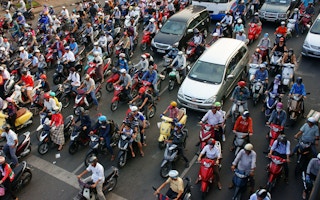This December’s climate change summit in Paris could at last see an ambitious, legally-binding deal. For the first time, this would encompass the bulk of global greenhouse gas emissions, since the biggest emitters—including the US, China, and India—are now closely engaged in the negotiation process.
Up to now, the focus of these and other countries in tackling climate change has mostly been on cutting emissions from power stations by replacing fossil fuels with renewables—rightly so. For according to the International Energy Agency, electricity and heat generation cause 42 per cent of global emissions from fuel combustion. But of the remainder, transport—particularly road users—is the largest offender, producing 23 per cent of global emissions.
So for any climate deal to succeed, it will need to broaden its focus from energy to address all the main sources of emissions. And the climate deal must provide the needed financial and technical backing for low-carbon transport. Otherwise, any climate deal in Paris is a no deal.
This challenge is most urgent in developing countries, where emissions are growing fast. Already non-OECD countries account for more than half of global transport emissions. Some 19 per cent comes from developing Asia alone. As incomes continue to rise, vehicle ownership in much of the region is growing at 8 per cent or more annually. At that rate, Asia’s vehicle fleet will double by 2024 and emissions will also more than double.
Historically, the cities in advanced countries grew slowly, while their transport systems were developed over the best part of a century. In the developing countries of Asia, meanwhile, villages and towns have mushroomed into megacities in just a few decades. For example, China now has 160 cities of more than 1 million and India has 47.
Unfortunately, in most cases, their transport systems have not kept pace with this expansion. The result is scenes familiar across Asia—city streets clogged with vehicles and crowds choking on plummeting air quality as they pack onto crowded public transport. We’ve all seen this from Manila to Mandalay, Bangkok to Bangalore.
Such conditions carry a high human and economic toll, beyond the gloom of living in soot stained surroundings under an ever present grey pall. About 2.6 million deaths were linked to outdoor air pollution in Asia and Pacific in 2012, according to the World Health Organization. Meanwhile, road congestion in Asia knocks 2-5 per cent off gross domestic product every year due to lost time and higher transport costs. In the Philippines where I am based, the estimated daily loss is more than $52 million. Without intervention, the problem will only get worse.
“
It’s time for low-carbon—and ideally low cost—transport to take its place alongside energy at the heart of the new climate debate in Paris.
Under pressure to produce immediate results, city mayors and officials often lack the technical know-how or finances to come up with lasting solutions.
To meet its transport needs, developing Asia needs to invest an estimated $2.5 trillion during the present decade. This is much more than the financing available from governments, the private sector, and international development assistance combined.
This is where climate finance can play an instrumental role—helping countries and cities to bridge the financing gap while giving priority to investments in low-carbon transport.
Recent experience shows that city transport options do not always have to be costly metro systems. In some locations, highly effective low-carbon transport can be set up relatively quickly and cheaply.
One such approach is Bus Rapid Transit (BRT). Such a system inaugurated during the summer in Yichang in Hubei Province, a Chinese city of 1.4 million urban residents, took just three years to develop and cost $99 million—somewhere between a tenth and a fiftieth of the cost per kilometre of building a metro line.
Through simple measures such as dedicated lanes and off-board fare collection, some 300,000 passengers a day there now enjoy safe, clean, convenient travel along a 24-kilometre line comparable with any metro.
A 2014 Institute for Transportation and Development Policy and University of California study estimates that carbon emissions per passenger kilometre using BRT are about one quarter those using private motor vehicles. Wider deployment of BRT and other forms of public transport in developing countries between now and 2050 would eliminate 40 per cent of global urban transport emissions.
Of course, BRTs are not the only remedy available to clogged cities—metros and conventional buses will continue to play a role, depending on local circumstances. But Yichang offers a low-cost model that could easily be replicated in many of Asia’s crowded cities—if the required expertise and finance are provided.
It’s time for low-carbon—and ideally low cost—transport to take its place alongside energy at the heart of the new climate debate in Paris.
Tyrrell Duncan is technical advisor for transport at the Asian Development Bank. This post is republished from the Asian Development Bank blog.






















